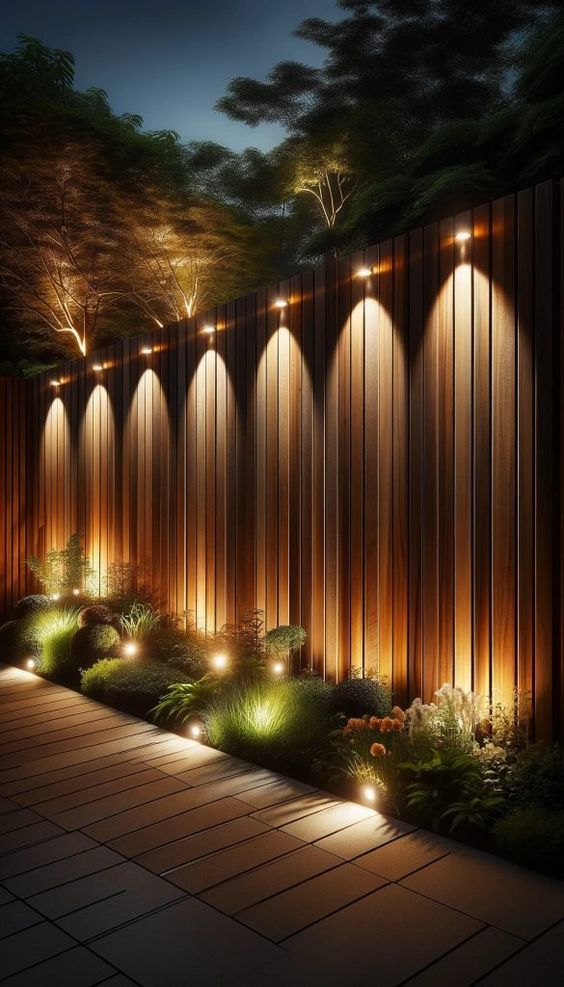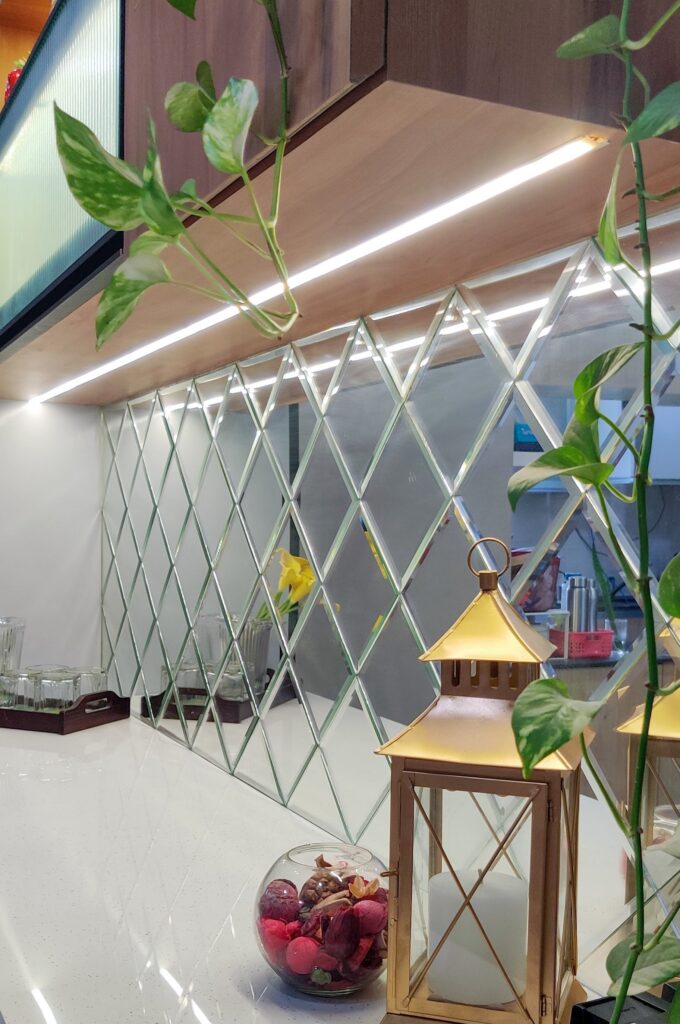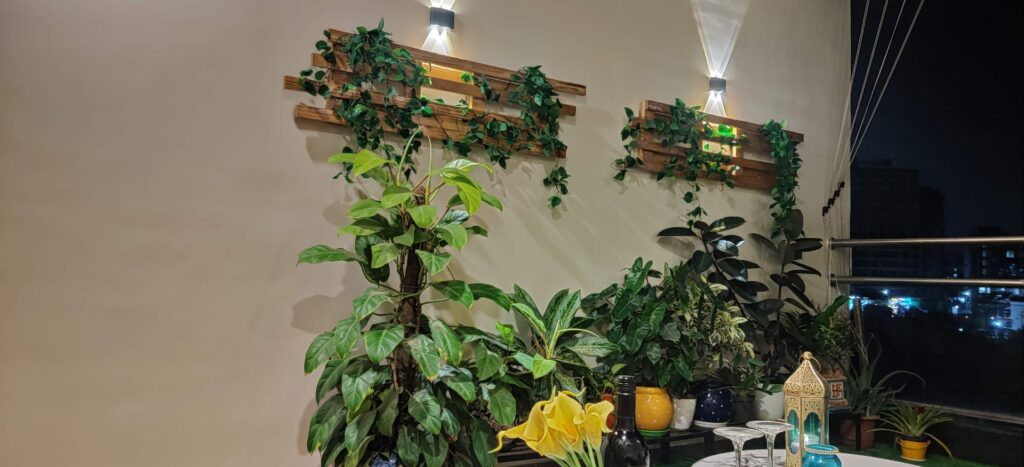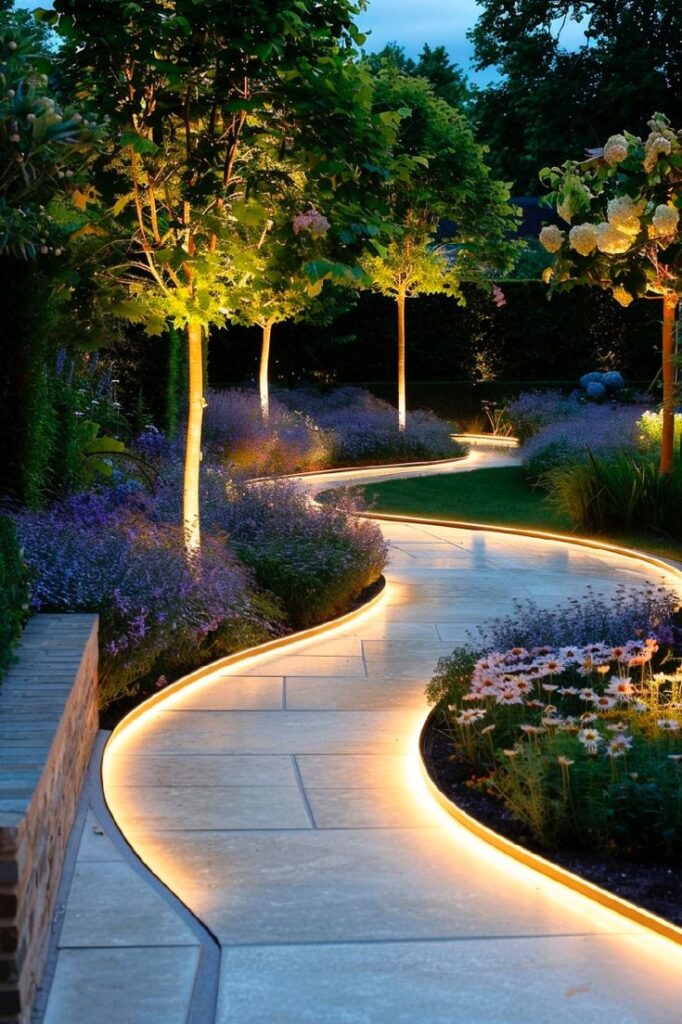3 Types of Interior Lighting
Lighting is one of the most essential elements in interior design, as it profoundly influences the ambiance, functionality, and aesthetics of a space. Beyond just illuminating a room, the right lighting effects can transform an interior by enhancing the overall mood, highlighting key features, and supporting the purpose of each area. Proper lighting ensures that spaces are not only visually appealing but also functional and comfortable. It can make small rooms feel larger, accentuate textures and colors, and direct focus to specific design elements such as artwork or architectural details.

Today we are going to discuss three primary types of lighting used in interiors i.e. ambient lighting, task lighting and accent lighting. By understanding these and layering them appropriately one can create dynamic interiors that cater to both practical needs and aesthetic preferences, elevating the overall user experience. So, let’s delve into these one by one and also as a bonus I will explain how we can layer these lighting for creating a proper ambience.
1. Ambient Lighting
Ambient lighting is the primary source of light in a space, providing overall illumination that ensures a room is comfortably lit for everyday activities. Often referred to as general lighting, it sets the tone for the room by establishing the overall brightness and creating a sense of warmth and openness.
Ambient lighting is essential because it ensures the space is usable and functional without being too harsh or overbearing. It is typically soft, diffused, and evenly distributed, reducing shadows and creating a comfortable atmosphere. In below photo you can see how the ambient light is evenly distributed
Ambient lights are typically ceiling-mounted or integrated into the architecture of the room. It provides overall illumination for general use.
The amount of ambient light needed will vary depending on the room’s purpose. In living rooms, softer ambient light might be preferred to create a cozy atmosphere, whereas in kitchens or home offices, brighter, more focused ambient light is necessary for practical tasks.
PRO TIP: Install dimmer switches for ambient lighting fixtures, it allows you to control the brightness and adjust the mood depending on the time of day or activity. Dimming the lights creates a more relaxed, intimate setting, while brightening them can energize the room.
Types of Ambient Lighting Fixtures:
a. Ceiling-Mounted Fixtures
Recessed Light (Downlights) : Installed into the ceiling, recessed lights provide a clean and modern look. When spaced correctly, they create even, shadow-free illumination. Recessed lighting is commonly used in kitchens, living rooms, and hallways for a minimalist, clutter-free aesthetic.
Chandeliers and Pendants: While often used decoratively, these hanging lights can also provide ample ambient light when placed in the center of a room or over a dining table. The light spreads out from the fixture, filling the space with general brightness.

Some pendant lights are big. Drum pendant lights are one of them that can be used as an ambient light source in a room. These feature a cylindrical, drum-shaped shade, usually fabric or metal, that diffuses light evenly.

Drum pendants provide soft, ambient light and are perfect for use over dining tables or in living rooms where you need a balance of illumination and decorative appeal.
b. Track Light
A track lighting system can be an effective and stylish way to provide ambient lighting, which is the main source of illumination that brightens up an entire room. It gives the flexibility to mount multiple light fixtures on a continuous track, allowing you to customize the direction and positioning of each light. Track light can be used to layer all the three types of lighting based on your requirements.

c. Natural Light
Daylight streaming through windows, skylights, or glass doors is an excellent source of ambient light. Maximizing natural light can reduce the need for artificial lighting during the day and create a warm, inviting atmosphere. Large windows, sheer curtains, and reflective surfaces can help enhance the amount of natural light in a space.

To incorporate Ambient light in interiors firstly consider the room function/ purpose. For example, in living rooms, softer ambient light might be preferred to create a cozy atmosphere, whereas in kitchens or home offices, brighter, more focused ambient light is necessary for practical tasks.
Also consider the size of the room, large rooms may require multiple sources of ambient light to ensure even coverage. This can be achieved with a combination of recessed lights, ceiling fixtures, and floor lamps. Conversely, smaller rooms may only need one central ceiling fixture to provide adequate ambient light.

By carefully selecting and positioning ambient lighting, you can transform any interior into a well-lit, comfortable, and visually appealing space. It serves as the backbone of a successful lighting design, ensuring both function and ambiance are achieved.
2. Task Lighting
Task lighting refers to lighting that is specifically designed to illuminate areas where activities or tasks take place, such as reading, cooking, working, or grooming. It is more focused and brighter than ambient lighting, providing direct illumination in areas where detail-oriented tasks are performed. Task lighting helps reduce eye strain, improves visibility, and enhances productivity, ensuring that the specific task is done efficiently and comfortably.

Common Types of Task Lighting Fixtures:
a. Desk Lamps
Desk lamps are often used in home offices, study areas, or bedside tables, providing focused light for reading, writing, or computer work.

Desk lamps have adjustable arms and swivel heads that allow you to direct light where it’s needed. Some desk lamps come with dimming options for flexibility.
b. Under-cabinet lighting
Installed under kitchen cabinets or shelving, this type of lighting brightens countertops and workspaces for tasks such as cooking, chopping, or food preparation.

LED strip lights are common options for under-cabinet lighting. It eliminates shadows cast by overhead fixtures, making tasks on the countertop easier and safer.
c. Pendant Lights
Pendant lights are suspended from the ceiling and provide directed light over specific areas such as kitchen islands, dining tables, or desks. They provide a balance of functionality and decorative appeal.

Pendants come in various styles and sizes, and they can be hung at adjustable heights to suit different tasks. Some pendant lights are small, compact pendants typically between 5-8 inches in diameter ideal for adding focused task lighting. Multiple mini pendants can be installed in a row for more extensive lighting coverage.

Some pendant lights feature an exposed bulb, often with a vintage or industrial design. They can be paired with decorative Edison bulbs to enhance the aesthetic. Exposed bulb pendants provide a raw, industrial feel and work well in spaces where you want to make the light bulb a focal point.

Hence, Pendant lights offer both functional illumination and decorative appeal. Whether you’re going for a minimalist modern look, a cozy rustic feel, or an industrial vibe, there’s a pendant light to suit every style and purpose.
To incorporate task lighting begin by assessing the specific tasks that take place in each room. Kitchens, home offices, reading nooks, makeup stations, and workbenches are some areas that typically require task lighting. By carefully choosing and positioning task lighting, you can ensure that specific areas of your home are well-lit for detailed activities, improving both functionality and aesthetics.
3. Accent Lighting
Accent lighting is a type of lighting that is used to highlight and draw attention to specific objects, architectural features, or areas within a space. Unlike ambient or task lighting, which serve functional purposes, accent lighting is primarily decorative and is used to create focal points, enhance the mood of a room, or bring attention to key design elements.

It adds depth and dimension to a space by creating contrast, making certain features stand out. It creates visual interest and adds drama by focusing light on a specific area. It is positioned to shine directly on the object or feature being highlighted, often at specific angles to enhance textures or shapes. Look below how beautifully it highlights the curved ceiling and created a visual interest.

Common Types of Accent Lighting Fixtures:
a. Wall sconces
These are installed directly on the wall and used to highlight artwork, architectural features, or decorative elements. Wall sconces provide soft, upward or downward lighting that accentuates textures or creates an intimate ambiance. Look in below photo how the directional wall scone highlight the fluted panel and making it a stand out piece in itself.

b. Spot Light
One of the most trending and modern way to add spot light as accent light is to install it on magnetic track. It comprises of a series of adjustable lights mounted on a track, often used to highlight multiple objects, such as paintings in an art gallery or a series of shelves or a texture wall. These can be used in combination with ambient lights that we had discussed earlier and you may already know that we can fix spot light anywhere along the track so it gives a lot more flexibility to highlight accent pieces.

Spotlights are Directional lights that focus on a single object or area, often used to highlight statues, plants, or other decorative items. Not only that if used in combination it can create the desired light effect. Spotlights create intense, focused illumination on a specific feature, making it stand out in the space. Look at the below photo how multiple spotlights are used to create an effect.

c. Picture Lights
Designed to specifically highlight paintings, photographs, or artwork. These are mounted on wall and highlight an artwork enhancing its visibility in the room.

d. Under cabinet Lights
Installed under cabinets or shelves to illuminate countertops or items on display. Look below how the profile LED that we have used in one of the projects helps to accentuate the counter and decorative elements. Below is an example of under cabinet light that we have provided in one of our projects. You can look for complete drawings of the same by clicking here

Under-cabinet lighting can provide both task and accent lighting, making it great for kitchens, bars, or display cabinets.
Accent lighting isn’t limited to interior spaces. You can use outdoor spotlights or uplights to highlight landscape features, such as trees, sculptures, or fountains. This type of lighting can transform a garden or patio into a visually striking area after dark, creating ambiance for outdoor gatherings. Look how we have used the accent lights to highlight the planters. You can see it complete electrical layout by clicking here.

Path lights can also serve as accent lighting, subtly illuminating walkways or garden paths while drawing attention to plants or water features. Look in the below photo how the accent light creates path and highlights plants. Also notice the light is very subtle not making it harsh on eyes and creating perfect ambience for outdoor area.

Hence by incorporating accent lighting thoughtfully, you can elevate the design of any room, adding emphasis to the key elements while creating a layered and balanced lighting scheme that enhances the overall ambiance of the space.
STEPS TO LAYER 3 TYPES OF INTERIOR LIGHTING
Incorporating ambient, task, and accent lighting into the interior of a room requires thoughtful planning and layering to ensure both functional and aesthetic balance. Here’s a step-by-step guide to incorporating each lighting layer effectively along with kind of summary for these 3 types of lighting:
1. Understand the Room’s Purpose
Before choosing lighting, it’s important to identify the primary function of the room. Different spaces require different lighting setups based on their activities. For instance, a living room may require softer lighting for relaxation, while a kitchen needs brighter lighting for cooking tasks.
2. Start with Ambient lighting
Ambient lighting provides the overall illumination needed to uniformly light up the entire room. It acts as the foundation for all other layers of lighting and should allow for comfortable navigation throughout the space.
Steps to incorporate ambient light:
- Choose the main light source – This could be a chandelier, flush-mount ceiling light, or recessed lighting, depending on the room’s size and style.
- Consider Natural light – Don’t overpower the room with brightness
- Dimming Capability – Allows for flexibility in the intensity of the ambient light
3. Incorporate Task lighting
Task lighting is used to provide focused illumination for specific activities such as reading, cooking, working, or grooming. It should be functional, concentrated, and positioned where the tasks will take place.
Steps to incorporate Task light:
- Identify key activity zones – Determine where the most practical work will happen. For example, in a kitchen, task lighting should illuminate countertops and the sink area. In a bedroom, it could be the reading nook or beside the bed.
- Choose appropriate fixtures – Select task lighting fixtures that suit the activity. For e.g. Desk lamps, under-cabinet lights, pendant lights, etc.
- Control Glare and Shadows – Task lighting should not create harsh glare or shadows. Place the tasks light carefully to achieve this.
4. Add accent Lighting
Accent lighting is used to highlight specific features or create visual interest in the room. It is primarily decorative and focuses on emphasizing design elements like artwork, architectural features, or textures.
Steps to incorporate Accent light:
- Identify focal points – Determine which elements in the room you want to highlight, such as artwork, bookshelves, sculptures, or a textured wall.
- Select directional Lighting fixtures – Use lighting fixtures such as spotlights, wall sconces, track lights, or recessed lights to shine on specific features.
5. Consider the room’s design and style
Choose lighting fixtures that align with the room’s overall design theme, whether it’s modern, industrial, rustic, or minimalist. For example, sleek, recessed lights work well in modern spaces, while ornate chandeliers may complement traditional interiors. Make sure that the materials and finishes of the lighting fixtures (such as brass, wood, or glass) enhance the room’s design elements.
6. Layer Lighting for flexibility
Install separate switches for each layer of lighting (ambient, task, and accent) to control them independently. This allows for flexibility in adjusting the lighting based on the time of day, activity, or desired ambiance.
At the end we can say that incorporating the right balance of ambient, task, and accent lighting is essential for creating a well-lit, functional, and aesthetically pleasing interior space. Ambient lighting lays the foundation by providing overall illumination, task lighting ensures focused light for specific activities, and accent lighting adds depth and highlights key features of the room. Together, these three lighting types work harmoniously to enhance any room’s atmosphere and design.
I hope this blog has helped you understand the importance of layering lighting in your interiors and inspired you to transform your space with the perfect lighting combination!
Remember to here to keep getting updates
Until Then Take care and Keep learning!!
See you soon…
Megha Srivastava



